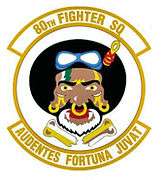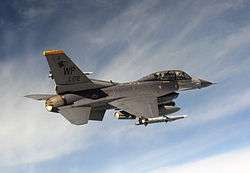80th Fighter Squadron
| 80th Fighter Squadron | |
|---|---|
|
80th Fighter Squadron F-16D Block 40G Fighting Falcon 89-0172 21 Oct 2010 | |
| Active | 1942–present |
| Country | United States |
| Branch | United States Air Force |
| Type | F-16 fighter squadron |
| Size | 16 aircraft |
| Nickname(s) |
Headhunters Juvats |
| Motto(s) | Audentes Fortuna Juvat[1] |
| Commanders | |
| Current commander | Lt Col Matthew "Trap" Crowell |
| Insignia | |
| Identification symbol |
 |
The 80th Fighter Squadron (traditionally nicknamed the "Headhunters", and since 1971 also the "Juvats") is an F-16 fighter squadron of the United States Air Force, currently part of the 8th Operations Group of the 8th Fighter Wing, and stationed at Kunsan Air Base, Republic of Korea.
The 80th has served in combat operations in World War II, the Korean War, and the Vietnam War.
History
Lineage
- Constituted 80 Pursuit Squadron (Interceptor) on 6 January 1942
- Activated on 10 January 1942
- Redesignated: 80 Fighter Squadron on 15 May 1942
- Redesignated: 80 Fighter Squadron (Two Engine) 22 July 1943
- Redesignated: 80 Fighter Squadron, Two Engine, on 20 August 1943
- Inactivated on 26 December 1945
- Redesignated 80 Fighter Squadron, Single Engine, on 14 January 1947
- Activated on 20 February 1947
- Redesignated: 80 Fighter Squadron, Jet, on 1 January 1950
- Redesignated: 80 Fighter-Bomber Squadron, on 20 January 1950
- Redesignated: 80 Tactical Fighter Squadron, on 1 July 1958
- Redesignated: 80 Fighter Squadron, on 3 February 1992.
Assignments
- 8 Pursuit (later, 8 Fighter) Group, 10 January 1942 – 26 December 1945
- 8 Fighter (later, 8 Fighter-Bomber) Group, 20 February 1947
- Attached to: 49 Fighter-Bomber Group, 11 August – 25 September 1950
- Attached to: 51 Fighter-Interceptor Group, 25 September – 27 October 1950
- Attached to: Twentieth Air Force, 21 October 1954 – 10 February 1955
- Attached to: 49 Fighter-Bomber Group, 10 February 1955 – 18 October 1956
- Attached to: 8 Fighter-Bomber Wing, 1 February – 30 September 1957
- 8 Fighter-Bomber (later, 8 Tactical Fighter) Wing, 1 October 1957
- Attached to 41st Air Division, 13 May – 17 June 1964
- 41st Air Division, 18 June 1964
- Attached to 2 Air Division, 30 October – 29 December 1964
- 6441 Tactical Fighter Wing, 1 April 1965
- Attached to 2d Air Division, 27 June – 26 August 1965
- 41st Air Division, 15 November 1966
- 347 Tactical Fighter Wing, 15 January 1968
- Attached to Detachment 1, 475 Tactical Fighter Wing, 15 February – 15 March 1971
- 3 Tactical Fighter Wing, 15 March 1971
- 8 Tactical Fighter Wing, 16 September 1974
- 8 Operations Group, 3 February 1992 – present
Stations
|
|
Aircraft
Operational history
The Headhunters' history began only one month after Pearl Harbor, as the squadron shipped out to fight in the Pacific Theater. The Squadron was first activated on 10 January 1942 at Mitchel Field in New York.
Originally designated as a pursuit squadron, they were redesignated in May 1942 as a fighter squadron. Attached to the 8th Fighter Group. One of the early squadron commanders, Edward "Porky" Cragg named the Squadron "The Headhunters" after the local New Guinean Headhunter tribes who hated the Japanese and helped to rescue downed pilots. He also commissioned a crew chief, M/Sgt. Yale Saffro, who was once offered a job to work for Walt Disney as a cartoonist but turned it down, to design the 80th's patch. (This original patch design can be seen "here"., and has been officially sanctioned by the Office of Air Force Heraldry for current uniform wear.)
The squadron saw action against the Japanese in the Pacific including deployments in Australia, New Guinea, the Schouten Islands, Morotai, Leyte, Mindoro, and Japan.[2]
It was later redesignated as the 80th Fighter Squadron, Single Engine, on 14 January 1947, the squadron reactivated on 20 February 1947 at Itazuke AB, Japan, and was assigned to the 8th Fighter (later, 8th Fighter-Bomber) Group. It would undergo a number of different attachments over the next few years. It was attached to 49th Fighter-Bomber Group from 11 August to 25 September 1950; the 51st Fighter-Interceptor Group from 25 September to 27 October 1950; the Twentieth Air Force from 21 October 1954 to 10 February 1955; the 49th Fighter-Bomber Group from 10 February 1955 to 18 October 1956; and the 8th Fighter-Bomber Wing from 1 February to 30 September 1957).

From 1947 to 1950, the squadron would operate the P-51, before switching to the F-80 Shooting Star in 1950. With their conversion to jet engines, the headhunters were redesignated as the 80th Fighter Squadron, Jet, on 1 January 1950. Later that month, they would become the 80th Fighter-Bomber Squadron. The outfit served in the Korean war in June and July 1953 while mostly flying the F-86. In 1956, the Headhunters would begin flying the F-100.
Following the squadron's engagement in the Korean War, the 80th was tasked with providing air defense in Japan and Korea (1953–1954), in Okinawa (1954–1956), and in Japan and Korea (1956–1971).[2]
In 1963, the Headhunters began flying the F-105 Thunderchief. In June 1964, they were attached to the 41st Air Division. They remained with the 41st for less than a year, moving to the 6441st Tactical Fighter Wing of the 2nd Air Division in April 1965. The squadron conducted temporary duty (TDY) combat operations in Southeast Asia from December 1964 to June 1965. During the conflict, headhunters were charged with attacking targets such as the Hai Nguyen Steel Plant, Haipong storage facilities, rail lines, and the Doumer Bridge.
During their time serving in the Vietnam War, the 80th conducted 7,384 combat missions in Southeast Asia, including 2,657 combat missions directly over North Vietnam, for a total of 17,104 total hours of active operations. For their role in the conflict, 80th pilots received 7 Silver Stars, 64 Distinguished Flying Crosses, and 426 Air Medals. The 80th earned one battle honor, the Republic of Vietnam Gallantry Cross (with Palm), and four Air Force Outstanding Unit Citations.".[3]
In the winter of 1967-1968, now assigned to the 347th Tactical Fighter Wing, the 80th began transition to the F-4C Phantom II. In January 1968 its few available aircrews and aircraft (most of its F-105 assets were in the process of augmenting units in Thailand and the F-4Cs at Yokota were not yet operational) were sent to Korea in reaction to the North Korean seizure of the USS Pueblo. During the summer of 1968 the 80th TFS became the first PACAF squadron to assign a contingent of experienced F-4 aircraft commanders and electronic warfare officers (EWOs) as F-4C Wild Weasel crews. The first fully modified F-4C Wild Weasel aircraft arrived in April 1969.
Between 1968 and 1971 the primary mission of the 80th TFS was to deploy on a rotating basis to Osan AB, Korea, providing a nuclear strike alert posture against targets in the Soviet Union, North Korea, and China, maintaining several aircraft on fifteen-minute alert. It also trained on conventional weapons. In 1970 all PACAF F-4 Wild Weasel crews transferred into the 80th TFS.
On 15 February 1971, the 80th TFS redeployed from Yokota to Kunsan AB, Korea, while temporarily assigned to Detachment 1, 475th Tactical Fighter Wing to begin the process of inactivation, with its personnel and aircraft transferred to the 35th TFS. Lt Gen Jay T. Robbins, a former 80th FS commander and World War II ace who was Vice Commander of Tactical Air Command, rescinded the inactivation and had the 80th TFS transferred to the 3rd Tactical Fighter Wing, in Korea. There it was re-staffed with personnel from the 391st Tactical Fighter Squadron, which was inactivated on 28 February. The 391st TFS's insignia had included the motto Audentes Fortuna Juvat, which subsequently became the "Headhunters" motto. On the 391st TFS sleeve patch, the scroll displaying the motto was such that when the patch was ripped off, the word "Juvat" was left in place. The former 391st aircrew did so with the consent of the 80th TFS commander at the time, Lt Col Soloman Harp III, who named himself the first "Juvat". The motto remained unofficial until approved on 9 October 1986.
In its history, the 80th FS has recorded 251 total air-to-air victories. The 80th TFS scored one air-to-air victory by an F-105 pilot, but an assigned officer detached at the time to the 13th TFS in Thailand, Captain Jeffrey Feinstein, was credited with five victories and ace status as an F-4 weapons system officer in 1972.
Today, the 80th flies the F-16CM and is stationed at Kunsan Air Base, Republic of Korea (ROK).
See also
References
![]() This article incorporates public domain material from the Air Force Historical Research Agency website http://www.afhra.af.mil/.
This article incorporates public domain material from the Air Force Historical Research Agency website http://www.afhra.af.mil/.
- ↑ Latin phrase translation.com Literally, "Chance (or luck) helps the audacious," but the squadron traditionally interprets as "Fortune Favors the Bold".
- 1 2 80th Fighter Squadron [80th FS]
- ↑ "80th Tactical Fighter Squadron". Archived from the original on 23 October 2009.




.svg.png)